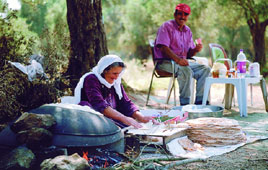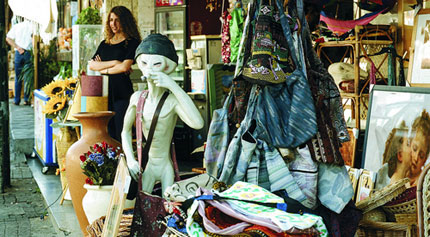 Druze villagers bake pita at roadside stands (Photo: Israel Ministry of Tourism) Druze villagers bake pita at roadside stands (Photo: Israel Ministry of Tourism) |
About an hour north of Tel Aviv, nestled in the Carmel Mountains between picturesque Zichron Yaakov and bustling Haifa, a Druze village called Daliat el-Carmel has become a popular weekend destination for bargain-hunting, ethnic cuisine, family activities and exploring history. "This is the southernmost Druze town in the world and the largest in Israel," says Ragaa Mansour, a member of the Druze sect that is based mainly in Lebanon and Syria. "We have a wonderful market, known throughout the world, and also lots of restaurants, cafés and inns."
Activities in Daliat el-Carmel and environs run from olive pressing and weaving demonstrations to biking, horseback riding, nature walks and guided 4x4 excursions.
Visitors also flock to the villages to sample stuffed grape leaves, squash dishes, mansaf (lamb cooked in a sauce of fermented dried yogurt and served with rice or groats), mujadara (a lentil and onion pilaf), bulgur, homemade labaneh cheese and fresh pita bread sprinkled with za'atar and hummus. Villagers even bake and sell pita at roadside stands for those who can't wait to find an eatery.
"The Druze are very polite and really welcome tourists no matter if they are English-speaking, German-speaking or Hebrew-speaking," says licensed tour guide Akiva Oren. "The food and the market are the main attractions, but on weekends the main street is so crowded with Israeli visitors that you may have to wait in line."
Exploring Druze heritage
Two years ago, Mansour opened the Carmel Center for Druze Heritage, a hands-on living museum dedicated to showcasing the traditional dress, foods, crafts and industries of the Druze people, religion and culture.
The religion started in 11th century Egypt as an offshoot of the Islamic Ismailia Movement, based on the Koran and other Arabic, Persian, Greek and ancient Eastern philosophies. It's a secretive sect whose tenets are only fully known to trained clergymen.
The community's watchwords are hospitality, generosity, courage and integrity, and the Druze in Israel's north are loyal citizens who've served in the Israel Defense Forces since 1956. That's why Israelis and foreigners alike feel comfortable exploring Daliat el-Carmel and the surrounding villages, where Elijah and Jesus once walked.
The modern Daliat el-Carmel was established in the 17th century by Druze émigrés from Lebanon. In 2003 it merged with Usfiya (also spelled Isfiya) to its immediate south, and officially the combined town is called simply Carmel. But natives still distinguish between the two. "Usfiya has 10,200 people and is about 17 percent Christian and three percent Muslim, and also there are some Jewish houses," Mansour says. The 13,000 residents of Daliat el-Carmel, which means "Vine of the Carmel," are virtually all Druze.
Home of Israel's national anthem
Mansour points out the little-known fact that the words to Israel's national anthem, Hatikvah, were written in Usfiya, her hometown.
As the story goes, the Galician poet Naphtali Herz Imber immigrated to Palestine In 1882 and served as a secretary of Sir Laurence Oliphant, a British Christian Zionist. Imber penned a book of poems while staying at the Oliphant House, an English-style mansion on a hill overlooking the Mediterranean. One of these poems was an updated version of "Our Hope," a work he first wrote in 1877 and that was later adapted and set to music as Israel's national anthem.
Today the Oliphant House is open to tourists and also includes a memorial site, Beit Yad Labanim, for fallen Druze soldiers, as well as an art collection documenting the signing of Israel's peace treaties with Egypt and Jordan.
Abu Antar, another popular destination here, is a factory specializing in authentic handicrafts made of fabric and other materials.
The Muhraka, a Carmelite Monastery, sits high on a mountain on the main road of Daliat el-Carmel. According to tradition, this spot is where the Prophet Elijah fought with the followers of the pagan god Ba'al and where he was fed by ravens in a cave while hiding from the wicked Queen Jezebel. The grounds include a lush grove and garden, and the roof of the monastery is an excellent observation point.
 Muhraka, a Carmelite Monastery, sits high on a mountain on the main road of Daliat el-Carmel. (Photo by Mordagan/Israel Ministry of Tourism) |
The Saturday market
No matter from which direction you're driving into Daliat el-Carmel, says Oren, the bonus is the beautiful scenery from all approaches. Even from the direction of Usfiya, which is where last year's devastating fire began and burned down much of the Carmel forest, the vistas are breathtaking, he says.
On weekends, hundreds of Israelis from the center and north of the country drive these roads to find bargains in Daliat el-Carmel's old marketplace, located at the heart of the village. Open on Saturdays, when many Israeli retail centers are closed for the Jewish Sabbath, the bazaar boasts dozens of stores offering varied wares, alongside stalls featuring Druze staples such as olive oil, olives and pita bread.
Within the market and along the alleyways branching off it are several art galleries, which often offer cultural events in the evenings. Along the way, visitors pass by old houses, prayer halls and holy sites, olive oil presses and textile workshops.
 The famous marketplace of Daliat el-Carmel (Photo: Israel Ministry of Tourism) |
At the end of one of these lanes is a shrine to Abu-Ibrahim, who was among the first emissaries sent out by the Egyptian Fatimid Caliph Al-Hakem in 996 CE to proclaim the Druze faith. Visitors remove their shoes before descending the stone steps to the most sacred spot in the shrine, which is where Abu-Ibrahim is believed to have hidden when facing persecution for proclaiming the faith. Today, Druze brides and grooms come to have their picture taken in front of the arched new prayer hall adjacent to the shrine.
Some of the residents of the private houses of Daliat el-Carmel welcome guests seeking to learn more about Druze architecture, culture and tradition. Area tour guides can provide information about where to find them.









